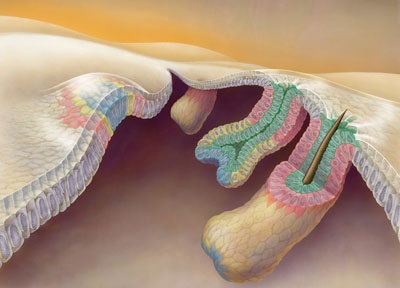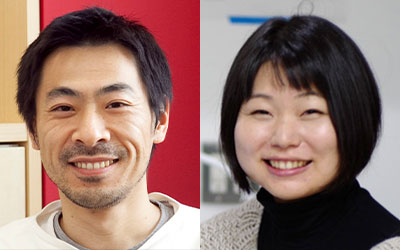Oct. 6, 2021 Research Highlight Biology
A telescopic model of the development of hair follicles
Atlas of hair follicle development could lead to new therapies for hair-loss disorders
 Figure 1: Hair follicles grow outward, like a telescopic antenna (prospective stem cells shown in pink). © 2021 Tomo Narashima
Figure 1: Hair follicles grow outward, like a telescopic antenna (prospective stem cells shown in pink). © 2021 Tomo Narashima
RIKEN biologists have untangled the process of hair follicle development by providing a dynamic four-dimensional atlas that explains the origins and development of diverse hair follicle cells, including adult hair follicle stem cells1.
Like other adult tissues in our bodies, hair follicles are regenerated from adult tissue stem cells. But the developmental origin of hair follicle stem cells has been largely unexplored because of the lack of markers for identifying and tracking each cell lineage.
Now, a team led by Hironobu Fujiwara of the RIKEN Center for Biosystems Dynamics Research has overcome this problem. The team created time-lapse videos of hair follicle development over several days in cultured skin samples taken from mouse embryos. Playing these videos in reverse allowed them to trace the fate of cells in developed hair follicles back to their earliest origins.
The team saw something akin to a dartboard. Cells within the primordial hair follicle epithelium, known as the placode, were arranged in a concentric manner according to their future fate. Cells at the center of the target gave rise to the bottom of the hair follicle, whereas cells at the outer edges remained at the surface of the skin.
They also performed gene-expression profiling of individual cells at various time points in hair follicle development and reconstructed cell lineage information. This analysis was consistent with the imaging data, reinforcing the idea that hair follicle stem cells originate from a specific zone in the outer ring of the early placode.
 Hironobu Fujiwara (left), Ritsuko Morita (right) and their co-workers have produced a dynamic four-dimensional atlas that explains the origins and development of diverse hair follicle cells. © 2021 RIKEN
Hironobu Fujiwara (left), Ritsuko Morita (right) and their co-workers have produced a dynamic four-dimensional atlas that explains the origins and development of diverse hair follicle cells. © 2021 RIKEN
The proliferation of the various cells caused the two-dimensional concentric rings in the placode to transform into a series of cylindrical compartments arranged like the components of an extendable telescope (Fig. 1)—leading the researchers to dub this type of developmental process the telescope model.
A similar phenomenon also accounts for the formation of legs, antennae and other cylindrical appendages in insects such as fruit flies. The telescope model might thus be an evolutionarily conserved mechanism of development more broadly, although it remains to be seen if other mammalian structures arise in this way. “It has not yet been properly investigated, making it an important question for future study,” says Fujiwara.
“This study provides a roadmap of normal hair follicle development, with detailed descriptions of the cellular dynamics and gene expression changes of entire cellular lineages,” says Fujiwara. “By comparing this roadmap with cases of congenital hair loss diseases, it may be possible to pinpoint where the abnormalities lie,” adds Ritsuko Morita, the first author of this study. “The findings could help drug developers to design new therapeutics to combat baldness and other types of hair loss.”
Related contents
- Hair follicle stem cells secrete protein that controls the skin’s sense of touch
- Basement membrane underpins tissue interactions in the skin
Reference
- 1. Morita, R., Sanzen, N., Sasaki, H., Hayashi, T., Umeda, M., Yoshimura, M., Yamamoto, T., Shibata, T., Abe T., Kiyonari, H. et al. Tracing the origin of hair follicle stem cells. Nature 594, 547–552 (2021). doi: 10.1038/s41586-021-03638-5
